JVC UX-G500V User Manual
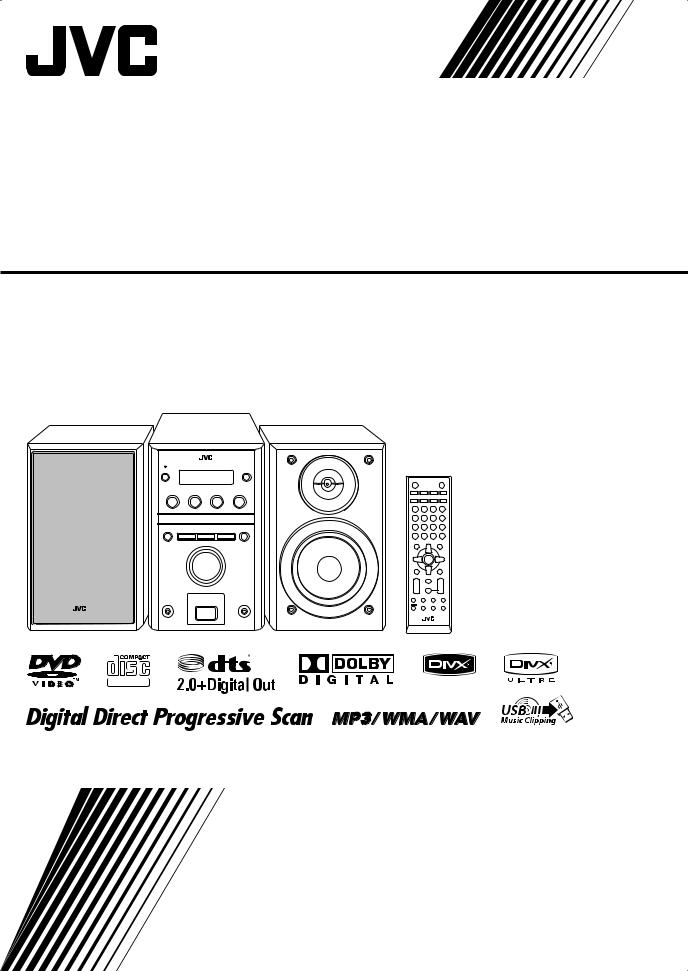
MICRO COMPONENT SYSTEM
UX-G500V
—Consists of CA-UXG500V and SP-UXG500V
SUPER VIDEO
INSTRUCTIONS
GVT0249-006A
[US/UB/UN/UG/UX/A/UH/UW]
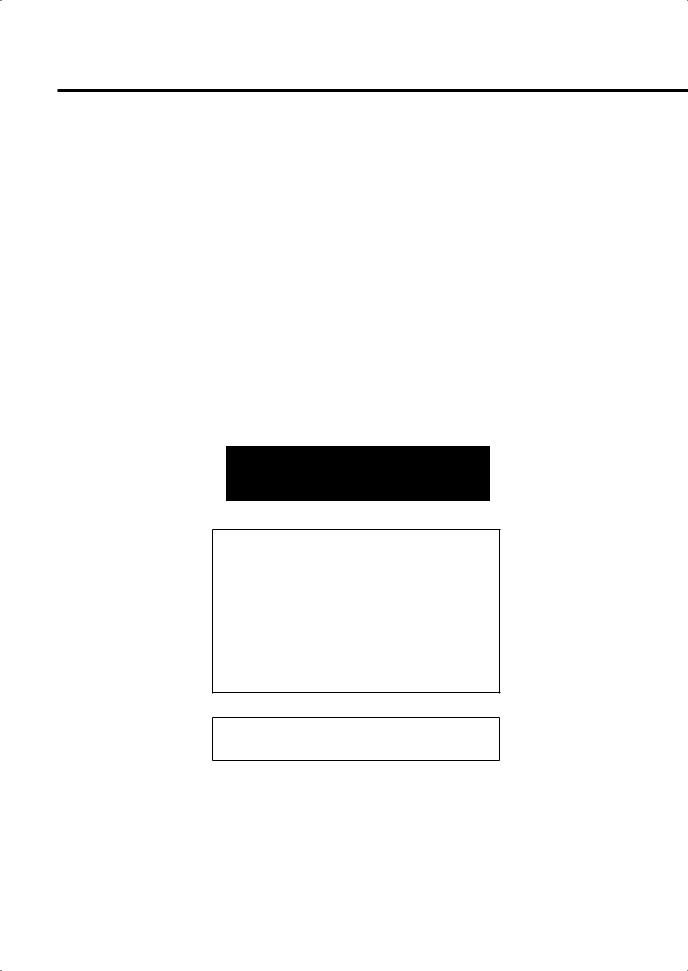
Warnings, Cautions and Others
CAUTION
The  button in any position does not disconnect the mains line.
button in any position does not disconnect the mains line.
Disconnect the mains plug to shut the power off completely (the STANDBY lamp goes off).
The MAINS plug or an appliance coupler is used as the disconnect device, the disconnect device shall remain readily operable.
•When the System is on standby, the STANDBY lamp lights red.
•When the System is turned on, the STANDBY lamp goes off. The power can be remote controlled.
CAUTION
To reduce the risk of electrical shocks, fire, etc.:
1.Do not remove screws, covers or cabinet.
2.Do not expose this appliance to rain or moisture.
IMPORTANT FOR LASER PRODUCTS
1.CLASS 1 LASER PRODUCT
2.CAUTION: Do not open the top cover or cabinet. There are no user serviceable parts inside the unit; leave all servicing to qualified service personnel.
3.CAUTION: Visible and/or invisible class 1M laser radiation when open. Do not view directly with optical instruments.
4.REPRODUCTION OF LABEL: CAUTION LABEL, PLACED INSIDE THE UNIT.
CAUTION
•Do not block the ventilation openings or holes.
(If the ventilation openings or holes are blocked by a newspaper or cloth, etc., the heat may not be able to get out.)
•Do not place any naked flame sources, such as lighted candles, on the apparatus.
•When discarding batteries, environmental problems must be considered and local rules or laws governing the disposal of these batteries must be followed strictly.
•Do not expose this apparatus to rain, moisture, dripping or splashing and that no objects filled with liquids, such as vases, shall be placed on the apparatus.
CAUTION
Excessive sound pressure from earphones or headphones can cause hearing loss.
G-1

Caution: Proper Ventilation
To avoid risk of electric shock and fire, and to prevent damage, locate the apparatus as follows:
1.Front: No obstructions and open spacing.
2.Sides/Top/ Back: No obstructions should be placed in the areas shown by the dimensions below.
3.Bottom: Place on the level surface. Maintain an adequate air path for ventilation by placing on a stand with a height of 10 cm or more.
Front view
Side view
[European Union only]
G-2

Introduction
Thank you for purchasing a JVC product. Please read all instructions carefully before operation, to ensure your complete understanding and to obtain the best possible performance from the System.
Precautions 
Installation
•Install the System in a location with adequate ventilation to prevent internal heat build-up in the System.
DO NOT install the System in a location near heat sources, or in a place subject to direct sunlight, excessive dust or vibration.
•Install in a place which is level, dry and neither too hot nor too cold—between 5°C and 35°C.
•Leave sufficient distance between the System and the TV.
•Keep the speakers away from the TV to avoid interference with the TV.
Power sources
•When unplugging the System from the wall outlet, always pull on the plug, not the power cord.
DO NOT handle the power cord with wet hands.
Moisture condensation
Moisture may condense on the lens inside the System in the following cases:
•After starting to heat the room
•In a damp room
•If the System is brought directly from a cold to a warm place.
Should this occur, the System may malfunction. In this case, leave the System turned on for a few hours until the moisture evaporates, unplug the power cord, then plug it in again.
Internal heat
•Make sure there is good ventilation around the System. Poor ventilation could overheat and damage the System.
DO NOT block the ventilation openings or holes. If they are blocked by a newspaper or cloth, etc., the heat may not be able to get out.
How to Read This Manual 
•Button and control operations are explained in the table below.
•Some related tips and notes are explained later in the sections “Learning More about This System” and “Troubleshooting,” but not in the same section explaining the operations ( INFO indicates that the content has some information).
Indicates that you press the button briefly.
|
Indicates that you press the button briefly |
|
|
and repeatedly until the option you want |
|
|
is selected. |
|
|
Indicates that you press one of the buttons. |
|
2sec. |
Indicates that you press and hold the |
|
|
button for a specified period. |
|
|
Indicates that you turn the control in the |
|
|
specified direction(s). |
|
ONLY |
Indicates that this operation is only |
|
Remote |
|
|
|
possible using the remote control. |
|
Main Unit |
Indicates that this operation is only |
|
possible using the main unit. |
||
ONLY |
How to cancel the demonstration
Press and hold DEMO button on the main unit (until “DEMO CLR” appears on the display) while on standby.
•Refer to the attached sheet “Information about the demonstration function.”
Others
Should any metallic object or liquid fall into the System, unplug the power cord and consult your dealer before operating any further.
DO NOT disassemble the System since there are no user serviceable parts inside.
•If you are not going to operate the System for an extended period of time, unplug the power cord from the wall outlet.
If anything goes wrong, unplug the power cord and consult your dealer.
1

Contents |
|
Connections ............................................................ |
4 |
Display Indicators .................................................... |
7 |
Daily Operations—Playback .................................... |
8 |
Listening to the Radio......................................................... |
9 |
Playing Back a Disc/USB Mass Storage Class Device..... |
10 |
Playing Back a Digital Audio Player ................................. |
12 |
Daily Operations—Sound & Other Adjustments......... |
13 |
Adjusting the Volume......................................................... |
13 |
Adjusting the Sound ........................................................... |
13 |
Creating a Soothing Tone for your Ear |
|
—MY SOUND................................................................. |
14 |
Creating 3-Dimensional Sound Field—3D Phonic ........ |
15 |
Making Dialogues Clear—Clear Voice ............................ |
15 |
Presetting Automatic DVD Sound Increase Level ......... |
15 |
Changing the Display Brightness ...................................... |
15 |
Setting the ECO (ecology) Mode....................................... |
16 |
Changing the Color System and Scanning Mode ........... |
16 |
Changing the Picture Tone ................................................ |
16 |
Setting the Clock.................................................................. |
17 |
Turning Off the Power Automatically ............................. |
18 |
Unique Video Disc/File Operations ............................ |
19 |
Selecting the Audio Track .................................................. |
19 |
Selecting the Subtitle Language ......................................... |
20 |
Special Effect Playback........................................................ |
21 |
Advanced Playback Operations ................................. |
22 |
Programming the Playing Order—Program Play........... |
22 |
Playing at Random—Random Play .................................. |
23 |
Playing Repeatedly .............................................................. |
24 |
Prohibiting Disc Ejection—Child Lock............................ |
24 |
Recording and Editing Operations............................. |
25 |
Recording from a Disc........................................................ |
26 |
Giving (Editing) Titles to Tracks or Groups ................... |
26 |
Entering Titles...................................................................... |
27 |
Erasing the Tracks or Groups............................................ |
28 |
On-Screen Operations .............................................. |
29 |
On-screen Bar Operations ................................................. |
29 |
Control Screen Operations ................................................ |
32 |
Daily Timer Operations............................................. |
34 |
Setting the Daily Timer....................................................... |
34 |
Setup Menu Operations............................................ |
36 |
Initial Settings ...................................................................... |
36 |
Additional Information ............................................ |
38 |
Learning More about This System.................................... |
38 |
Maintenance......................................................................... |
40 |
Troubleshooting .................................................................. |
41 |
Display Messages for Recording or Editing |
|
Operations........................................................................ |
42 |
Language Code List ............................................................. |
43 |
Optical Digital Out Signals ................................................ |
44 |
Operating JVC’s TVs Using the Remote Control........... |
44 |
Specifications ....................................................................... |
45 |
Parts Index ............................................................. |
46 |
2

Playable Disc/File Types 
COMPACT
DIGITAL VIDEO |
SUPER VIDEO |
|
|
|
DIGITAL AUDIO |
||||
•CD-R/-RW: Recorded in the Audio CD, Video CD, and SVCD formats. MP3, WMA, WAV, JPEG, MPEG-1, MPEG-2 and DivX files written in accordance with the “ISO 9660” format can also be played.
•DVD-R/-RW, +R/+RW: Recorded in the DVD Video format. MP3, WMA, WAV, JPEG, MPEG-1, MPEG-2 and DivX files written in the UDF-Bridge format can also be played.
•DVD-R/-RW: Recorded in the DVD Video Recording (VR) format.
•USB mass storage class device: MP3, WMA, WAV, JPEG, MPEG-1, MPEG-2 and DivX* files.
In addition to the above discs/files, this System can play back audio data recorded on CD-Extra and CD-G (CD-Graphics).
•The following discs cannot be played back: DVD-RAM, CD-I (CD-I Ready), CD-ROM, and Photo CD.
Playing back these discs will generate noise and damage the speakers.
•CD Text and DVD Text can be played, but Text information will not be shown on the display.
•In this manual, “file” and “track” are used interchangeably.
•It is possible to play back finalized +R/+RW (DVD Video format only) discs. DVD indicator lights on the front display panel when a +R/+RW disc is loaded.
•“DVD Logo” is a trademark of DVD Format/Logo Licensing Corporation.
•This System can play back EVERIO files (see page 41) recorded on DVD, CD*, and USB mass storage class
device*.
* Only when the maximum bit rate is less than 2 Mbps.
About color system
This System accommodates both NTSC and PAL system and can play back discs/files recorded in either system. To change the color system, see page 16.
Note on Region Code
DVD players and DVDs have their own Region Code numbers. This System can play back only DVDs with an appropriate Region Code number.
•For details, see “Specifications” on page 45.
•“RG ERROR” appears if DVD with other Region Code is loaded.
Ex.: For Southeast Asia and Hong Kong region
Caution for DualDisc playback
The Non-DVD side of a “DualDisc” does not comply with the “Compact Disc Digital Audio” standard. Therefore, the use of the Non-DVD side of a DualDisc in this product may not be recommended.
IMPORTANT: Before playing a disc/file, make sure of the
following...
•Turn on the TV and select an appropriate input mode on the TV to view the pictures or on-screen displays.
•For disc/file playback, you can change the initial setting to your preference. See “Setup Menu Operations” on
page 36.
If “ ” appears on the TV screen when you press a button, the disc/file cannot perform the operation you have tried to do.
” appears on the TV screen when you press a button, the disc/file cannot perform the operation you have tried to do.
•When playing a multi-channel encoded software, the System properly converts the multi-channel signals into 2 channels, and emits the downmixed sound from the speakers. To enjoy the powerful sound of these multichannel encoded software, connect a proper decoder or an amplifier with a proper built-in decoder to the OPTICAL DIGITAL OUT terminal on the rear.
3

Connections INFO
Do not connect the power cord until all other connections have been made.
•Connect VIDEO OUT directly to the video input of your TV. Connecting VIDEO OUT to a TV via a VCR may interfere with your viewing when playing back copyprotected discs/files. Connecting VIDEO OUT to an integrated TV/VCR system may also interfere with your viewing.
Rear panel
Supplied accessories
Check to be sure that you have all the following items.
•FM antenna (×1)
•AM loop antenna (×1)
•Composite video cord (×1)
•Remote control, RM-SUXG500VU (×1)
•Batteries (×2)
•AC plug adapter (×1)—not supplied for Australia, Thailand, Hong Kong region and the Middle East.
If any items are missing, consult your dealer immediately.
~From AM/FM antenna
See page 5.
ŸFrom the speakers
See page 5.
!From the powered subwoofer
See page 6.
⁄From the digital input of digital audio component
See page 5.
@From the input of TV/monitor
See page 6.
¤To a wall outlet
Plug in the power cord only after all connections have been completed.
•If the wall outlet does not match the AC plug, use the supplied AC plug adapter (not supplied for Australia, Thailand, Hong Kong region and the Middle East).
Front panel
From the digital audio player
See page 6.
From the USB mass storage class device
See page 6.
From the headphones
4
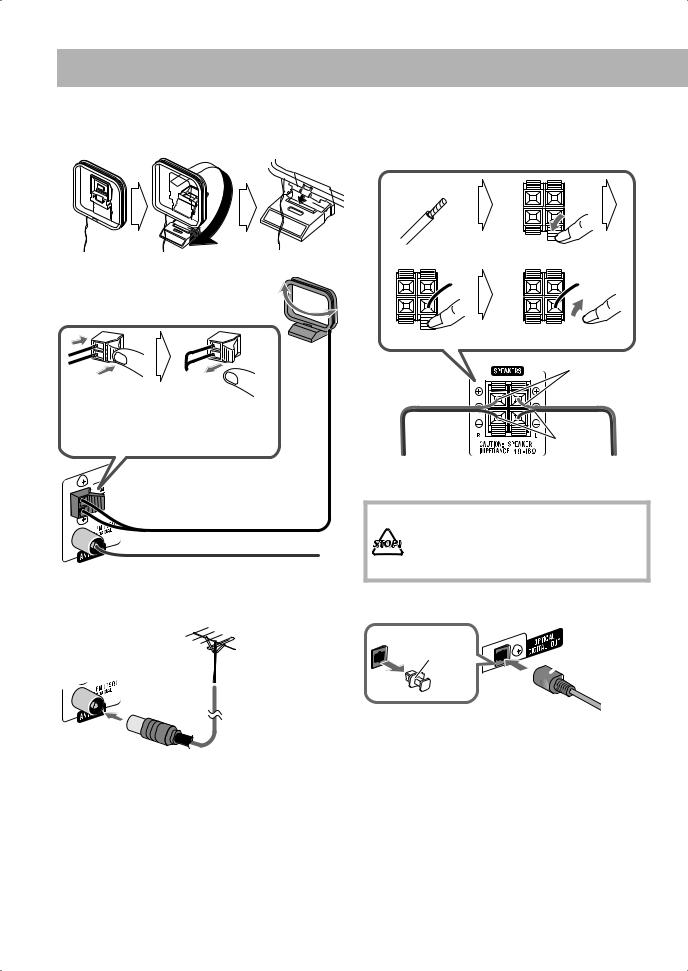
~ AM/FM antenna |
Ÿ Speakers |
To assemble the AM loop antenna |
• When connecting the speaker cords, match the polarity |
|
of the speaker terminals: red to (+) and black to (–) |
To connect AM/FM antenna
AM loop antenna (supplied)
Turn it until the best reception is obtained.
If the cords are covered with vinyl, remove the vinyl to expose the tip of the cord by twisting the vinyl.
FM antenna (supplied)
Extend it so that you can obtain the best reception.
For better FM reception
FM outdoor antenna (not supplied)
Disconnect the supplied FM antenna, and connect to an outdoor FM antenna using a 75 Ω wire with coaxial type connector.
Press and hold
Insert |
Release |
|
Red |
|
Black |
From right |
From left |
speaker |
speaker |
•DO NOT connect more than one speaker to each terminal.
•DO NOT push or pull the speakers as this will damage the foot spacers at the bottom of the speakers.
!Digital audio component
Optical digital
Protective cap |
cord (not |

 supplied)
supplied)
•Set “DIGITAL AUDIO OUTPUT” in the “AUDIO” menu correctly according to the connected digital audio equipment (see page 37).
•The digital signal through the OPTICAL DIGITAL OUT terminal is transmitted only when “DVD/CD” is selected as the source.
5
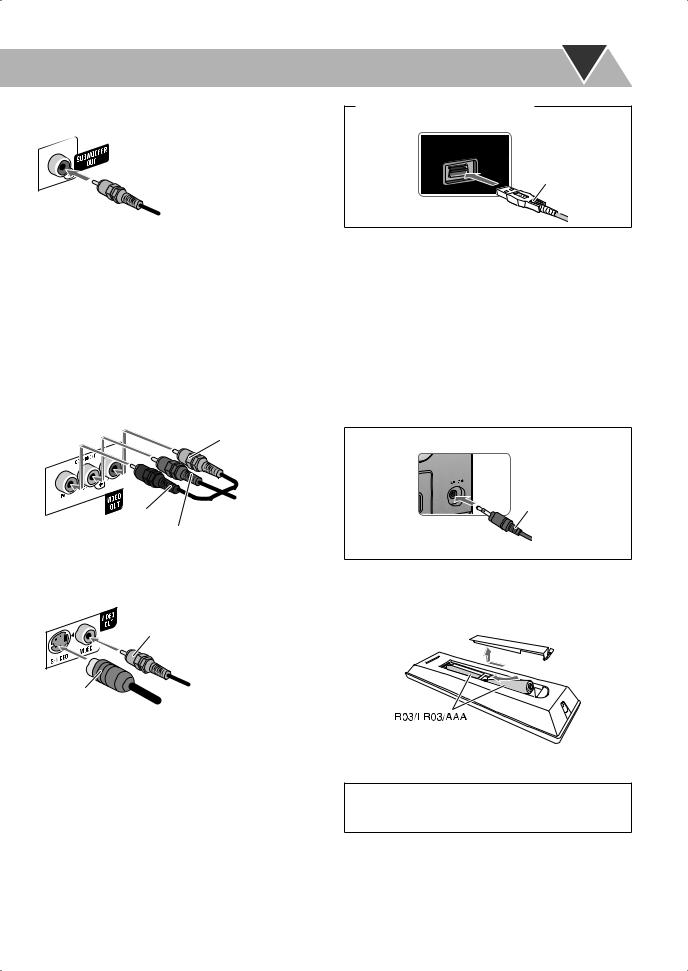
⁄ To connect the powered subwoofer
From the powered subwoofer (not supplied)
The connected subwoofer can reproduce the bass sounds recorded in front left and right channels, but cannot reproduce the LFE signals encoded in multi-channel software.
•Before plugging the System to the power supply, make sure that the powered subwoofer is turned off.
@ TV/monitor
Connect the COMPONENT jacks, S-VIDEO jack, or VIDEO jack; whichever you want to use.
•You can get better picture quality in the order of— Composite video ]S-Video ]Component video.
Green
Red |
Component video cord |
|
(not supplied) |
|
Blue |
•This connection allows you to use the progressive scanning mode. To select progressive (PROGRESS) scanning mode (see page 16), use VIDEO OUT (COMPONENT) jacks.
Composite video cord (supplied)
S-Video cord  (not supplied)
(not supplied)
•After connecting a TV, select the appropriate video signal output according to the connection method. See “Changing the Color System and Scanning Mode” on page 16.
When connecting a USB mass storage class device |
On the front |
panel |
USB cable |
(not supplied) |
•When connecting with a USB cable, use the USB 2.0 cable whose length is less than 1 m.
•You can connect a USB mass storage class device such as a USB flash memory device, hard disk drive, multimedia card reader, etc. to this System.
•You cannot connect a computer to the USB memory terminal ( ) of the System.
) of the System.
•You cannot connect JVC Everio camcorder to the USB memory terminal ( ) of the System.
) of the System.
•Noise and static electricity may stop the USB mass storage class device sound. In this case, disconnect and connect the USB mass storage class device again after turning off the System.
When connecting a digital audio player
On the front panel
Stereo mini plug (not supplied)
From audio output (or headphone out, etc.)
Preparing the remote control 
Insert the battery into the remote control by matching the polarity ( + and –) correctly.
If the range or effectiveness of the remote control decreases, replace both batteries.
Caution
Battery shall not be exposed to excessive heat such as sunshine, fire, or the like.
When using the remote control
Point the top of the remote control towards the remote sensor as directly as possible. If you operate it from a diagonal position, the operating range (approx. 5 m) may be shorter.
6

Display Indicators
The indications on the display tell you a lot of things while you are operating the System.
Before operating the System, be familiar with when and how the indicators illuminate on the display.
1USB indicator
•Lights when “USB MEM” is selected as the source. 2 REC (recording) indicator
•Lights when recording started.
3Disc format indicators
•SVCD: lights when playing back an SVCD.
•VCD: lights when playing back a VCD.
•CD: lights when playing back a CD.
•DVD: lights when playing back a DVD. 4 Playback mode indicators
•Repeat Mode indicators:
–1 : lights when One Track/File/Chapter/Step Repeat is activated.
– : lights when One Group/Title/Original Program/ Play List Repeat is activated.
: lights when One Group/Title/Original Program/ Play List Repeat is activated.
–
 : lights when All Track/File/Title/Original Program Repeat is activated.
: lights when All Track/File/Title/Original Program Repeat is activated.
•RND: lights when Random Play is activated.
•PRGM: lights when Program Play is activated.
5 
 (EALA surround mode) indicator
(EALA surround mode) indicator
•Lights when EALA surround sound is activated. 6 PRGR (progressive) indicator
•Lights when the progressive scanning mode is selected.
7S.TURBO (Sound Turbo) indicator
•Lights when Sound Turbo II is activated. 8 RESUME indicator
•Lights when the System memorizes the position where the playback is interrupted.
9AHB indicator
•Lights when AHB Pro (Active Hyper Bass Pro) is activated.
p (My Sound) indicator
(My Sound) indicator
•Lights when MY SOUND is activated.
qRadio band indicators
•AM: lights when tuning in to an AM station.
•FM: lights when tuning in to an FM station. w FM reception indicators
•S (stereo): lights while an FM stereo station with sufficient signal strength is tuned in.
•M (monaural): lights while receiving an FM stereo station in monaural.
eDaily Timer indicators
• : lights when Daily Timer is on standby or is being set; flashes while it is working.
: lights when Daily Timer is on standby or is being set; flashes while it is working.
•1/2/3: lights when a Daily Timer (1, 2, or 3) is on
standby or is working; flashes while being set.
r3D P. (3D Phonic) indicator
•Lights when 3D Phonic is activated. t  (Clear Voice) indicator
(Clear Voice) indicator
•Lights when Clear Voice is activated. y Audio format indicators
•MP3: lights when an MP3 file is detected.
•WMA: lights when a WMA file is detected. u Main display
•While listening to the radio: band (or preset number) and station frequency appear.
•While “AUDIO IN” is selected as the source: “AUDIO IN” appears.
•While playing a disc or file: current status appears. i A.STBY (Auto Standby) indicator
•Lights when Auto Standby is activated.
•Flashes when playback stops with Auto Standby activated.
oSLEEP indicator
• Lights when the Sleep Timer is activated.
7
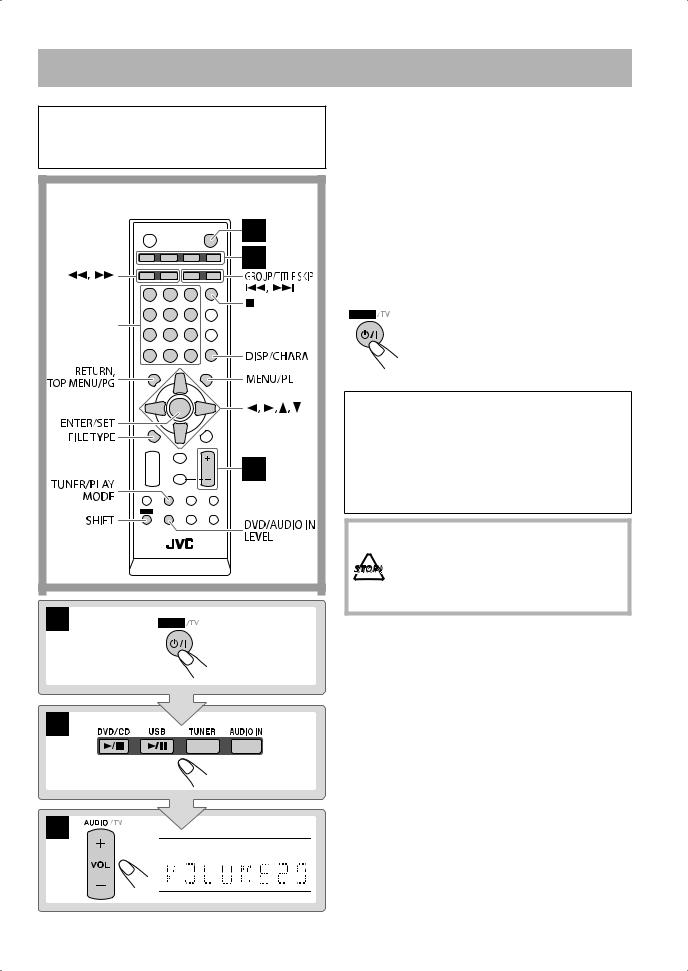
Daily Operations—Playback
In this manual, operations using the remote control are mainly explained; however, you can use the buttons and controls on the main unit if they have the same (or similar) name and marks.
Remote control
Number
buttons
1 Turn on the power.
The STANDBY lamp on the main unit turns off.
•Instead of pressing 
 AUDIO/TV, the System is turned on by pressing one of the source buttons.
AUDIO/TV, the System is turned on by pressing one of the source buttons.
2Select the source.
•Playback automatically starts if the selected source is ready.
•You can change the display information by pressing DISP/CHARA. For details, see page 17.
3 Adjust the volume.
To turn off (standby) the System
The STANDBY lamp on the main unit lights in red.
•A small amount of power is always consumed even while on standby.
For private listening
Connect a pair of headphones to the PHONES jack on the main unit. The sound will no longer come out of the speakers. “H-PHONE” appears on the display for a while. Be sure to turn down the volume before connecting or putting on the headphones.
•Disconnecting the headphones will activate the speakers again.
DO NOT turn off (standby) the System with the volume set at an extremely high level; otherwise, the sudden blast of sound may damage your hearing, speakers and/or headphones when you turn on the System or start playback.
8
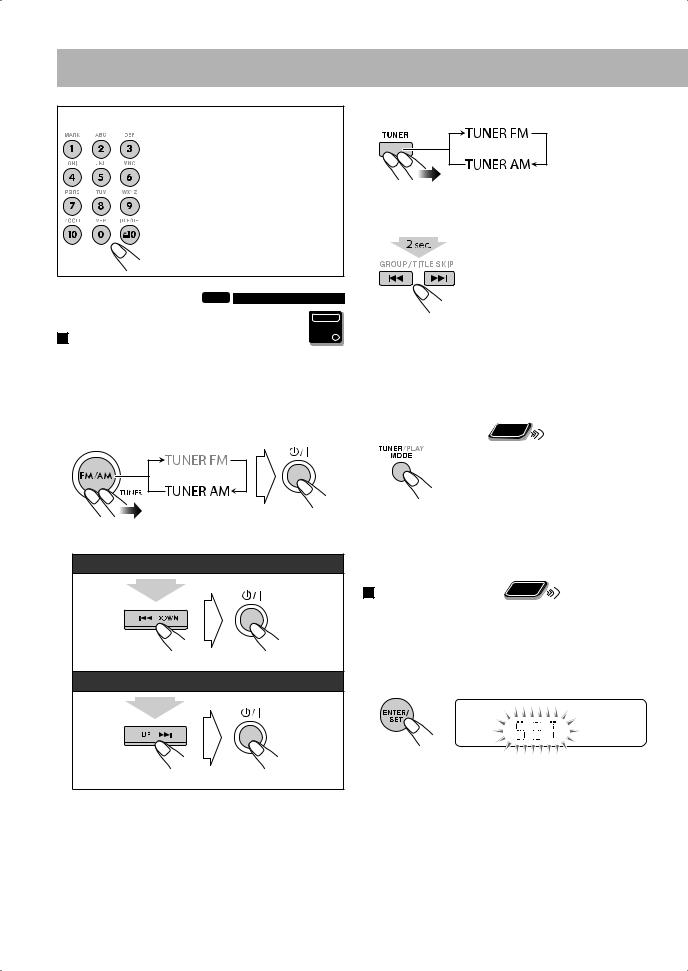
How to select a number
Examples:
To select number 5, press 5. To select number 10, press 10.
To select number 15, press  10, 1, then 5.
10, 1, then 5.
To select number 30, press  10, 3, then 0.
10, 3, then 0.
To select number 125, press  10,
10,  10, 1, 2, then 5.
10, 1, 2, then 5.
Listening to the Radio INFO
Main Unit
ONLY
To select the AM tuner interval spacing
Some countries space AM stations 9 kHz apart, and other countries use 10 kHz spacing. Before operating the tuner, select the appropriate AM tuner interval spacing used for your area.
1Select “TUNER AM,” then turn off (standby) the System.
2Select the AM tuner interval spacing. To select 9 kHz:
(while holding...)
To select 10 kHz:
(while holding...)

 To select the band (FM or AM)
To select the band (FM or AM)

 To tune in to a station
To tune in to a station
While FM or AM is selected...
Frequency starts changing on the display.
When a station (frequency) with sufficient signal strength is tuned in, the frequency stops changing.
•When you repeatedly press the button, the frequency changes step by step.
To manually stop the search, press either button.
Remote
If the FM reception is poor |
ONLY |
The M (monaural) indicator lights on the display. Reception will improve though stereo effect is lost— Monaural reception.
To restore the stereo effect, press the button again. The M (monaural) indicator disappears.
To preset the stations |
Remote |
ONLY |
You can preset 30 FM and 15 AM stations.
1Tune in to a station you want to preset.
•You can also store the monaural reception mode for FM preset stations if it is selected.
2Activate the preset number entry mode.
•Finish the following process while the indication on the display is flashing.
9

3 Select a preset number for the station you store.
• To select a number, see “How
to select a number” on page 9.
• You can also use the ¡ or 1 button.
Playing Back a Disc/USB Mass Storage Class
Device INFO 
To insert a disc |
Main Unit |
|
ONLY |
4 Store the station.
To tune in to a preset station |
Remote |
ONLY |
|
|
1 Select the band (FM or AM).
2 Select the preset number for the station you stored.
• To select a number, see “How
to select a number” on page 9.
• You can also use the ¡ or 1 button.
•When using an 8 cm disc, place it on the inner circle of the disc tray.
To close the disc tray, press 0 again.
•If you press DVD/CD 6, disc tray closes automatically and playback starts (depending on how the disc is programmed internally).
To connect a USB mass storage class device
•For connecting a USB mass storage class device, see page 6.
•Always set volume level to the minimum level when connecting or disconnecting a USB mass storage class device.
•To disconnect a USB mass storage class device safely, turn off the System before disconnecting it.

 To play back a disc/USB mass storage class device
To play back a disc/USB mass storage class device
To start:
Disc |
USB mass storage class device |
||||
|
|
|
|
|
|
|
|
|
|
|
|
To pause: |
|
|
To stop: |
||
|
|
|
|
|
|
|
|
|
|
|
|
|
|
|
|
|
|
To release, press the same button again.
10

If different types of playable files (audio/still picture/moving picture) are recorded
•Select a file type to play (see the following and “FILE TYPE” in “PICTURE” menu on page 37).
•You can use the control screen appears on the TV. (For still/moving picture files, it appears while playback is stopped.) For details, see page 32.
•The System can store the stop point, and when you start playback again by pressing DVD/CD 6 or USB 6 (even while on standby), it starts from the position where you have stopped—Resume Play. (RESUME indicator lights on the display when you stop playback.)
To stop completely while Resume is activated, press
7 twice. (To deactivate Resume, see “RESUME” in “OTHERS” menu on page 37.)
On-screen guide icons
•During playback, the following icons may appear on the TV:
At the beginning of a scene containing multi-angle views.
At the beginning of a scene containing multi-audio sounds.
At the beginning of a scene containing multi-subtitles.
•The following icons will also be shown on the TV to
indicate your current operation.  ,
,  ,
,  ,
,  ,
,  ,
, 
•To deactivate the on-screen guide icon, see “ON SCREEN GUIDE” in “OTHERS” menu on page 37.

 To select the file type
To select the file type
(while holding...)
To select a title/group |
Remote |
|
ONLY |
||
|
• Not applicable for DVD-VR.
While playing...
(while holding...)

 To select a chapter/track/file
To select a chapter/track/file
• For VCD/SVCD, cancel PBC (see page 12).
While playing...
• When you press 4 for the first time, you will go back to the beginning of the current chapter/track/file.
Remote
To locate a particular portion |
ONLY |
• This does not function for JPEG files.
While playing...
•For MP3/WMA/WAV/MPEG-1/MPEG-2/DivX files, the search speed and indications on the TV are different from those above.
•No sound comes out if searching is carried out while showing the moving picture.
To return to normal playback, press DVD/CD 6 or USB 6 (depending on the current source).
For DivX/MPEG-1/MPEG-2 files, each time you press the 3 or 2 button, you can skip to a scene by 30 seconds or 5 minutes depending on the files.
11

Remote
To locate an item directly |
ONLY |
You can select a title/chapter/track/file directly and start playback.
•For DVD Video, you can select a title before starting playback, while you can select a chapter after starting playback.
• To select a number, see “How to select a number” on page 9.
Remote
|
To play back using the disc menu |
ONLY |
|
|
|
For DVD Video: |
|
|
1 Show the disc menu. |
|
|
2 Select an item on the disc menu.
To move to the next or previous page of the current menu:

 Moves to the next page.
Moves to the next page.
 Moves to the previous page.
Moves to the previous page.
To return to the previous menu:
(while holding...)
To cancel PBC, press 7, then select a track by using the number buttons (see page 9). Playback starts with the selected track.
To reactivate PBC, press 7 (twice if RESUME is turned on), then press DVD/CD 6.
Playing Back a Digital Audio Player 
• For connecting a digital audio player, see page 6.
You can listen to the digital audio player connected to the AUDIO IN jack.
•Make sure to turn down the volume on the System to minimum level before starting playback.
•For some discs, you can also select items by entering the number using the number buttons.
For SVCD/VCD with PBC:
While playing a disc with PBC, “PBC” appears on the display.
When disc menu appears on the TV, select an item on the menu. Playback of the selected item starts.
• To select a number, see “How to select a number” on page 9.
Remote
To adjust the audio input level |
ONLY |
|
If the sound from the device connected to the
AUDIO IN jack is too loud or too quiet, you can preset the audio input level through the AUDIO IN jack (without changing the volume level).
While “AUDIO IN” is selected as the source...
(while holding...)
•As the number of the level increases, the preset input level is increased.
12
